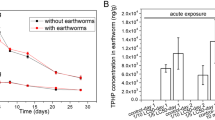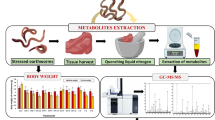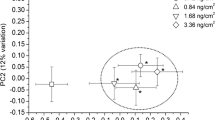Abstract
1H nuclear magnetic resonance (1H NMR)-based metabolomics was utilized to elucidate the earthworm sub-lethal toxicity after exposure to the persistent environmental contaminant phenanthrene. Earthworms were exposed to 0.05, 0.2 and 0.4 mg/cm2 of phenanthrene [which correspond to 1/32nd to 1/4th of the 48-h LC50 (concentration that causes 50 % mortality), respectively] via contact tests over 1, 2 and 3 days of dermal contact. 1H NMR-based metabolomic analysis of the polar and non-polar fractions of the earthworm tissue extracts revealed heightened Eisenia fetida toxic responses with both longer exposure times and higher phenanthrene concentrations. Principal component analysis (PCA) of the polar fraction showed significant separation between control and exposed earthworms along PC1 for all phenanthrene concentrations on each day. The PCA of the non-polar fraction showed significant separation between the controls and exposed earthworms for only the first day of exposure. These results suggested that alanine, glutamate, maltose, and fatty acids were potential indicators of phenanthrene exposure. Interruption in energy production due to a deactivation of the succinate dehydrogenase enzyme in the Krebs cycle was also postulated in exposed earthworms. Cross-validated partial least squares-regression models showed that the polar metabolic profile of E. fetida was weakly but significantly correlated to phenanthrene exposure concentrations after day 1 and day 2 of exposure. Overall, this study indicates that with longer exposures, contact time becomes more important than concentration in discriminating between control and exposed earthworms. This study also shows that NMR-based metabolomics has promise as a powerful ecotoxicological tool for elucidating the mode of toxicity of contaminants.




Similar content being viewed by others
References
Beckwith-Hall, B. M., Nicholson, J. K., Nicholls, A. W., Foxall, P. J. D., Lindon, J. C., Connor, S. C., et al. (1998). Nuclear magnetic resonance spectroscopic and principal components analysis investigations into biochemical effects of three model hepatotoxins. Chemical Research in Toxicology, 11(4), 260–272.
Ben-Izhak Monselise, E., Parola, A. H., & Kost, D. (2003). Low-frequency electromagnetic fields induce a stress effect upon higher plants, as evident by the universal stress signal, alanine. Biochemical and Biophysical Research Communications, 302(2), 427–434. doi:10.1016/S0006-291x(03)00194-3.
Boroujerdi, A. F. B., Vizcaino, M. I., Meyers, A., Pollock, E. C., Huynh, S. L., Schock, T. B., et al. (2009). NMR-based microbial metabolomics and the temperature-dependent coral pathogen Vibrio coralliilyticus. Environmental Science and Technology, 43, 7658–7664.
Brown, M. B., & Forsythe, A. B. (1974). Robust tests for equality of variances. Journal of the American Statistical Association, 69(346), 364–367.
Brown, S. A. E., McKelvie, J. R., Simpson, A. J., & Simpson, M. J. (2010). H-1 NMR metabolomics of earthworm exposure to sub-lethal concentrations of phenanthrene in soil. Environmental Pollution, 158(6), 2117–2123. doi:10.1016/J.Envpol.2010.02.023.
Brown, S. A. E., Simpson, A. J., & Simpson, M. J. (2008). Evaluation of sample preparation methods for nuclear magnetic resonance metabolic profiling studies with Eisenia fetida. Environmental Toxicology and Chemistry, 27(4), 828–836.
Brown, S. A. E., Simpson, A. J., & Simpson, M. J. (2009). 1H NMR metabolomics of earthworm responses to sub-lethal PAH exposure. Environmental Chemistry, 6, 432–440.
Bucker, M., Glatt, H. R., Platt, K. L., Avnir, D., Ittah, Y., Blum, J., et al. (1979). Mutagenicity of phenanthrene and phenanthrene K-region derivatives. Mutation Research/Genetic Toxicology, 66(4), 337–348.
Bundy, J. G., Keun, H. C., Sidhu, J. K., Spurgeon, D. J., Svendsen, C., Kille, P., et al. (2007). Metabolic profile biomarkers of metal contamination in a sentinel terrestrial species are applicable across multiple sites. Environmental Science and Technology, 41(12), 4458–4464.
Bundy, J. G., Lenz, E. M., Bailey, N. J., Gavaghan, C. L., Svendsen, C., Spurgeon, D., et al. (2002). Metabonomic assessment of toxicity of 4-fluoroaniline, 3,5-difluoroaniline and 2-fluoro-4-methylaniline to the earthworm Eisenia veneta (Rosa): Identification of new endogenous biomarkers. Environmental Toxicology and Chemistry, 21(9), 1966–1972.
Bundy, J. G., Osborn, D., Weeks, J. M., Lindon, J. C., & Nicholson, J. K. (2001). An NMR-based metabonomic approach to the investigation of coelomic fluid biochemistry in earthworms under toxic stress. FEBS Letters, 500(1–2), 31–35.
Bundy, J. G., Sidhu, J. K., Rana, F., Spurgeon, D. J., Svendsen, C., Wren, J. F., et al. (2008). ‘Systems toxicology’ approach identifies coordinated metabolic responses to copper in a terrestrial non-model invertebrate, the earthworm Lumbricus rubellus. BMC Biology, 6(25), 1–21.
Bundy, J. G., Spurgeon, D. J., Svendsen, C., Hankard, P. K., Weeks, J. M., Osborn, D., et al. (2004). Environmental metabonomics: Applying combination biomarker analysis in earthworms at a metal contaminated site. Ecotoxicology, 13(8), 797–806.
Craig, S. A. S. (2004). Betaine in human nutrition. American Journal of Clinical Nutrition, 80(3), 539–549.
Edwards, C. A., & Bohlen, P. J. (1992). The effects of toxic-chemicals on earthworms. Reviews in Environmental Contaminant Toxicology, 125, 23–99.
Ekman, D. R., Teng, Q., Villeneuve, D. L., Kahl, M. D., Jensen, K. M., Durhan, E. J., et al. (2008). Investigating compensation and recovery of fathead minnow (Pimephales promelas) exposed to 17 alpha-ethynylestradiol with metabolite profiling. Environmental Science and Technology, 42(11), 4188–4194. doi:10.1021/es8000618.
Ekman, D. R., Teng, Q. N., Villeneuve, D. L., Kahl, M. D., Jensen, K. M., Durhan, E. J., et al. (2009). Profiling lipid metabolites yields unique information on sex- and time-dependent responses of fathead minnows (Pimephales promelas) exposed to 17 alpha-ethynylestradiol. Metabolomics, 5(1), 22–32. doi:10.1007/s11306-008-0138-y.
Eriksson, L., Johansson, E., Kettaneh-Wold, N., Trygg, J., Wikstrom, C., & Wold, S. (2006). Multi- and megavariate data analysis part 1: Basic principles and applications (2nd ed.). Umea: Umetrics AB.
Erstfeld, K. M., & Snow-Ashbrook, J. (1999). Effects of chronic low-level PAH contamination on soil invertebrate communities. Chemosphere, 39(12), 2117–2139.
Fallahtafti, S., Rantanen, T., Brown, R. S., Snieckus, V., & Hodson, P. V. (2012). Toxicity of hydroxylated alkyl-phenanthrenes to the early life stages of Japanese medaka (Oryzias latipes). Aquatic Toxicology, 106, 56–64. doi:10.1016/JAquatox201110007.
Felig, P. (1973). Glucose–alanine cycle. Metabolism clinical and experimental, 22(2), 179–207.
Felig, P., & Wahren, J. (1970). Evidence for a glucose–alanine cycle: Amino acid metabolism during muscular exercise. Journal of Clinical Investigation, 49(6), 282.
Fitzpatrick, L. C., Sassani, R., Venables, B. J., & Goven, A. J. (1992). Comparative toxicity of polychlorinated-biphenyls to earthworms Eisenia foetida and Lumbricus terrestris. Environmental Pollution, 77(1), 65–69.
Forcella, M., Berra, E., Giacchini, R., Rossaro, B., & Parenti, P. (2007). Increased alanine concentration is associated with exposure to fenitrothion but not carbamates in Chironomus riparius larvae. Ecotoxicology and Environment Safety, 66(3), 326–334. doi:10.1016/j.ecoenv.2006.10.015.
Guo, Q., Sidhu, J. K., Ebbels, T. M. D., Rana, F., Spurgeon, D. J., Svendsen, C., et al. (2009). Validation of metabolomics for toxic mechanism of action screening with the earthworm Lumbricus rubellus. Metabolomics, 5(1), 72–83. doi:10.1007/S11306-008-0153-Z.
Horton, H. R., Moran, L. A., Scrimgeour, K. G., Perry, M. D., & Rawn, J. D. (2006). Principles of biochemistry (4th ed.). Upper Saddle River, NJ: Pearson Prentice Hall.
Johnsen, A. R., Wick, L. Y., & Harms, H. (2005). Principles of microbial PAH-degradation in soil. Environmental Pollution, 133(1), 71–84. doi:10.1016/JEnvpol200404015.
Jones, O. A. H., Spurgeon, D. J., Svendsen, C., & Griffin, J. L. (2008). A metabolomics based approach to assessing the toxicity of the polyaromatic hydrocarbon pyrene to the earthworm Lumbricus rubellus. Chemosphere, 71(3), 601–609.
Lankadurai, B. P., Wolfe, D. M., Simpson, A. J., & Simpson, M. J. (2011a). 1H NMR-based metabolomic analysis of the time-dependent response of Eisenia fetida after sub-lethal phenanthrene exposure. Environmental Pollution, 159(10), 2845–2851. doi:10.1016/j.envpol.2011.04.04.
Lankadurai, B. P., Wolfe, D. M., Simpson, A. J., & Simpson, M. J. (2011b). 1H NMR-based metabolomic observation of a two-phased toxic mode of action in Eisenia fetida after sub-lethal phenanthrene exposure. Environmental Chemistry, 8, 105–114.
Laor, Y., Farmer, W. J., Aochi, Y., & Strom, P. F. (1998). Phenanthrene binding and sorption to dissolved and to mineral-associated humic acid. Water Research, 32(6), 1923–1931.
Lundstedt, S., Haglund, P., & Oberg, L. (2006). Simultaneous extraction and fractionation of polycyclic aromatic hydrocarbons and their oxygenated derivatives in soil using selective pressurized liquid extraction. Analytical Chemistry, 78(9), 2993–3000. doi:10.1021/Ac052178f.
McKelvie, J. R., Wolfe, D. M., Celejewski, M., Simpson, A. J., & Simpson, M. J. (2010). Correlations of Eisenia fetida metabolic responses to extractable phenanthrene concentrations through time. Environmental Pollution, 158(6), 2150–2157. doi:10.1016/J.Envpol.2010.02.022.
McKelvie, J. R., Yuk, J., Xu, Y. P., Simpson, A. J., & Simpson, M. J. (2009). H-1 NMR and GC/MS metabolomics of earthworm responses to sub-lethal DDT and endosulfan exposure. Metabolomics, 5(1), 84–94. doi:10.1007/s11306-008-0122-6.
Mizock, B. A. (1995). Alterations in carbohydrate-metabolism during stress: A review of the literature. American Journal of Medicine, 98(1), 75–84.
Nelson, A. (1987). Penetration of mercury-adsorbed phospholipid monolayers by polynuclear aromatic-hydrocarbons. Analytica Chimica Acta, 194, 139–149.
Nelson, A., Auffret, N., & Borlakoglu, J. (1990). Interaction of hydrophobic organic-compounds with mercury adsorbed dioleoylphosphatidylcholine monolayers. Biochimica et Biophysica Acta, 1021(2), 205–216.
Neuhauser, E. F., & Callahan, C. A. (1990). Growth and reproduction of the earthworm Eisenia Fetida exposed to sublethal concentrations of organic-chemicals. Soil Biology & Biochemistry, 22(2), 175–179.
Nissim, I., Hardy, M., Pleasure, J., & States, B. (1992). A mechanism of glycine and alanine cytoprotective action: Stimulation of stress-induced HSP70 mRNA. Kidney International, 42(3), 775–782.
OECD. (1984). Test no. 207: Earthworm, acute toxicity tests. OECD Guidelines for the Testing of Chemicals, Section 2: Effects on Biotic Systems. doi:10.1787/9789264070042-en.
Parrish, A. R., Alejandro, N. F., Bowes, R. C., & Ramos, K. S. (1998). Cytotoxic response profiles of cultured renal epithelial and mesenchymal cells to selected aromatic hydrocarbons. Toxicology In Vitro, 12(3), 219–232.
Perera, F., Tang, W. Y., Herbstman, J., Tang, D., Levin, L., Miller, R., et al. (2009). Relation of DNA methylation of 5′-CpG island of ACSL3 to transplacental exposure to airborne polycyclic aromatic hydrocarbons and childhood asthma. PLoS ONE, 4(2), e4488. doi:10.1371/journal.pone.0004488.
Perugini, M., Visciano, P., Manera, M., Turno, G., Lucisano, A., & Amorena, M. (2007). Polycyclic aromatic hydrocarbons in marine organisms from the Gulf of Naples, Tyrrhenian Sea. Journal of Agricultural and Food Chemistry, 55(5), 2049–2054. doi:10.1021/Jf0630926.
Petersen, C. R., Holmstrup, M., Malmendal, A., Bayley, M., & Overgaard, J. (2008). Slow desiccation improves dehydration tolerance and accumulation of compatible osmolytes in earthworm cocoons (Dendrobaena octaedra Savigny). Journal of Experimental Biology, 211(12), 1903–1910. doi:10.1242/jeb.017558.
Roberts, M. H, Jr, Hargis, W. J., Strobel, C. J., & De Lisle, P. F. (1989). Acute toxicity of PAH contaminated sediments to the estuarine fish, Leiostomus xanthuru. Bulletin of Environmental Contamination and Toxicology, 42, 142–149.
Rochfort, S. J., Ezernieks, V., & Yen, A. L. (2009). NMR-based metabolomics using earthworms as potential indicators for soil health. Metabolomics, 5(1), 95–107. doi:10.1007/S11306-008-0140-4.
Simpson, A. J., & Brown, S. A. (2005). Purge NMR: Effective and easy solvent suppression. Journal of Magnetic Resonance, 175(2), 340–346.
Simpson, M. J., & McKelvie, J. R. (2009). Environmental metabolomics: New insights into earthworm ecotoxicity and contaminant bioavailability in soil. Analytical and Bioanalytical Chemistry, 394(1), 137–149. doi:10.1007/s00216-009-2612-4.
Son, A. J., Shin, K. H., Lee, J. U., & Kim, K. W. (2003). Chemical and ecotoxicity assessment of PAH-contaminated soils remediated by enhanced soil flushing. Environmental Engineering Science, 20(3), 197–206.
Svendsen, C., Spurgeon, D. J., Hankard, P. K., & Weeks, J. M. (2004). A review of lysosomal membrane stability measured by neutral red retention: Is it a workable earthworm biomarker? Ecotoxicology and Environment Safety, 57(1), 20–29. doi:10.1016/j.ecoenv.2003.08.009.
Sverdrup, L. E., Nielsen, T., & Krogh, P. H. (2002). Soil ecotoxicity of polycyclic aromatic hydrocarbons in relation to soil sorption, lipophilicity, and water solubility. Environmental Science and Technology, 36(11), 2429–2435. doi:10.1021/Es010180s.
Tintos, A., Gesto, M., Miguez, J. M., & Soengas, J. L. (2007). Naphthalene treatment alters liver intermediary metabolism and levels of steroid hormones in plasma of rainbow trout (Oncorhynchus mykiss). Ecotoxicology and Environmental Safety, 66(2), 139–147. doi:10.1016/JEcoenv200511008.
Tuffnail, W., Mills, G. A., Cary, P., & Greenwood, R. (2009). An environmental H-1 NMR metabolomic study of the exposure of the marine mussel Mytilus edulis to atrazine, lindane, hypoxia and starvation. Metabolomics, 5(1), 33–43.
Viant, M. R. (2008). Recent developments in environmental metabolomics. Molecular BioSystems, 4(10), 980–986.
Viant, M. R., Bundy, J. G., Pincetich, C. A., de Ropp, J. S., & Tjeerdema, R. S. (2005). NMR-derived developmental metabolic trajectories: An approach for visualizing the toxic actions of trichloroethylene during embryogenesis. Metabolomics, 1(2), 149–158. doi:10.1007/s11306-005-4429-2.
Viant, M. R., Rosenblum, E. S., & Tjeerdema, R. S. (2003). NMR-based metabolomics: A powerful approach for characterizing the effects of environmental stressors on organism health. Environmental Science and Technology, 37(21), 4982–4989. doi:10.1021/Es034281x.
Whitfield Åslund, M., Celejewski, M., Lankadurai, B. P., Simpson, A. J., & Simpson, M. J. (2011a). Natural variability and correlations in the metabolic profile of healthy Eisenia fetida earthworms observed using 1H NMR metabolomics. Chemosphere, 83(8), 1096–1101.
Whitfield Åslund, M., Simpson, A. J., & Simpson, M. J. (2011b). 1H NMR metabolomics of earthworm responses to polychlorinated biphenyl (PCB) exposure in soil. Ecotoxicology, 20(4), 836–846.
Wilcke, W. (2007). Global patterns of polycyclic aromatic hydrocarbons (PAHs) in soil. Geoderma, 141(3–4), 157–166. doi:10.1016/J.Geoderma.2007.07.007.
Williams, T. D., Wu, H. F., Santos, E. M., Ball, J., Katsiadaki, I., Brown, M. M., et al. (2009). Hepatic transcriptomic and metabolomic responses in the stickleback (Gasterosteus aculeatus) exposed to environmentally relevant concentrations of dibenzanthracene. Environmental Science and Technology, 43(16), 6341–6348. doi:10.1021/Es9008689.
Wilson, S. C., & Jones, K. C. (1993). Bioremediation of soil contaminated with polynuclear aromatic-hydrocarbons (PAHs): A review. Environmental Pollution, 81(3), 229–249.
Wu, H. F., Southam, A. D., Hines, A., & Viant, M. R. (2008). High-throughput tissue extraction protocol for NMR and MS-based metabolomics. Analytical Biochemistry, 372(2), 204–212. doi:10.1016/jab200710002.
Yuk, J., McKelvie, J. R., Simpson, M. J., Spraul, M., & Simpson, A. J. (2010). Comparison of 1-D and 2-D NMR techniques for screening earthworm responses to sub-lethal endosulfan exposure. Environmental Chemistry, 7(6), 524–536.
Yuk, J., Simpson, A. J., & Simpson, M. J. (2011). 1D and 2D NMR metabolomics of earthworm responses to sub-lethal trifluralin and endosulfan exposure. Environmental Chemistry, 8, 281–294.
Acknowledgment
Funding was provided by the Natural Sciences and Engineering Research Council (NSERC) Strategic Grants Program. We would like to extend thanks to Jimmy Yuk for technical assistance and valuable discussions.
Author information
Authors and Affiliations
Corresponding author
Electronic supplementary material
Below is the link to the electronic supplementary material.
The online version of this article contains supplementary material, which is available to authorized users.
Rights and permissions
About this article
Cite this article
Lankadurai, B.P., Wolfe, D.M., Whitfield Åslund, M.L. et al. 1H NMR-based metabolomic analysis of polar and non-polar earthworm metabolites after sub-lethal exposure to phenanthrene. Metabolomics 9, 44–56 (2013). https://doi.org/10.1007/s11306-012-0427-3
Received:
Accepted:
Published:
Issue Date:
DOI: https://doi.org/10.1007/s11306-012-0427-3




